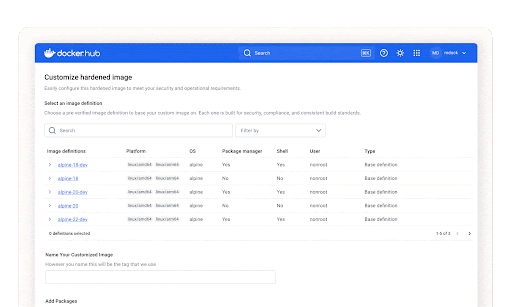Introducing Hardened Images | Docker
Extracto
Find secure images purpose-built for modern production environments with Docker Hardened Images.
Resumen
Resumen Principal
Docker, una empresa líder que potencia la entrega de software a escala global con más de 14 millones de imágenes y 11 mil millones de descargas mensuales en Docker Hub, ha hecho de la seguridad una piedra angular de su plataforma. Tras inversiones previas como las Docker Official Images, el soporte SBOM y Docker Scout, la compañía introduce ahora Docker Hardened Images (DHI). Estas imágenes de contenedor, seguras por defecto y optimizadas para entornos de producción modernos, están diseñadas para reducir drásticamente la superficie de ataque hasta en un 95%. Curadas y mantenidas por Docker, aseguran un número casi nulo de CVEs conocidos y se actualizan continuamente. DHI aborda desafíos sistémicos como la integridad del software, la superficie de ataque generada por imágenes base infladas y la alta sobrecarga operativa de la gestión de vulnerabilidades, permitiendo a los desarrolladores enfocarse en la innovación en lugar del parcheo constante. Su diseño busca una integración fluida y ofrece flexibilidad, redefiniendo la seguridad de la cadena de suministro de software.
Elementos Clave
-
Introducción de Docker Hardened Images (DHI): Docker presenta DHI como un avance crucial en la seguridad de la cadena de suministro de software. Estas imágenes de contenedor están diseñadas de forma segura por defecto y están optimizadas específicamente para entornos de producción modernos. Se distinguen por su superficie de ataque drásticamente reducida (hasta un 95% menos), su mantenimiento y curación continuos por parte de Docker para garantizar un número cercano a cero de CVEs conocidos, y su compatibilidad con distribuciones populares como Alpine y Debian, facilitando una integración sin necesidad de reconfiguración o cambios drásticos en la pila tecnológica.
-
Abordaje de Desafíos Sistémicos de Seguridad: El lanzamiento de DHI responde a problemas recurrentes expresados por los clientes, incluyendo la creciente preocupación por la integridad del software (verificar que los componentes no hayan sido alterados), el problema de la superficie de ataque que surge de imágenes base infladas con paquetes innecesarios, y la sobrecarga operativa para equipos de seguridad y desarrolladores. Estos últimos están atrapados en ciclos constantes de parcheo y gestión de CVEs, lo que desvía recursos de la entrega de nuevas funcionalidades.
-
Propuesta de Valor en Tres Áreas Esenciales: DHI ofrece valor significativo a través de una migración sin fisuras, permitiendo la integración en flujos de trabajo existentes al soportar las distribuciones y herramientas que los desarrolladores ya utilizan (el cambio puede ser tan simple como actualizar una línea en un Dockerfile). Proporciona una personalización flexible, permitiendo ajustes como certificados o scripts sin comprometer la base de seguridad endurecida. Finalmente, asegura un parcheo automatizado y respuesta rápida a CVEs, con Docker monitoreando continuamente las fuentes upstream y reconstruyendo las imágenes con nuevas certificaciones.
-
Filosofía Técnica "Distroless" y Reducción de la Superficie de Ataque: Docker Hardened Images se construyen siguiendo una filosofía distroless, que implica la eliminación de componentes innecesarios en producción como shells, gestores de paquetes y herramientas de depuración. Aunque útiles en desarrollo, estos elementos expanden significativamente la superficie de ataque, ralentizan los tiempos de inicio y complican la gestión de la seguridad. Al incluir solo las dependencias de tiempo de ejecución esenciales, DHI logra una reducción de hasta el 95% en la superficie de ataque, ofreciendo contenedores más ligeros, rápidos y robustos.
Análisis e Implicaciones
La introducción de Docker Hardened Images marca un avance estratégico
Contenido
From the start, Docker has focused on enabling developers to build, share, and run software efficiently and securely. Today, Docker Hub powers software delivery at a global scale, with over 14 million images and more than 11 billion pulls each month. That scale gives us a unique vantage point into how modern software is built and the challenges teams face in securing it.
That’s why we’ve made security a cornerstone of our platform. From trusted Docker Official Images to SBOM support for transparency, the launch of Docker Scout for real-time vulnerability insights, and a hardened Docker Desktop to secure local development, every investment reflects our commitment to making software supply chain security more accessible, actionable, and developer-first.
Now, we’re taking that commitment even further.
We’re excited to introduce Docker Hardened Images (DHI) — secure-by-default container images purpose-built for modern production environments.
These images go far beyond being just slim or minimal. Docker Hardened Images start with a dramatically reduced attack surface, up to 95% smaller, to limit exposure from the outset. Each image is curated and maintained by Docker, kept continuously up to date to ensure near-zero known CVEs. They support widely adopted distros like Alpine and Debian, so teams can integrate them without retooling or compromising compatibility.
Plus, they’re designed to work seamlessly with the tools you already depend on. We’ve partnered with a range of leading security and DevOps platforms, including Microsoft, NGINX, Sonatype, GitLab, Wiz, Grype, Neo4j, JFrog, Sysdig and Cloudsmith, to ensure seamless integration with scanning tools, registries, and CI/CD pipelines.
What we’re hearing from customers
We talk to teams every day, from fast-moving startups to global enterprises, and the same themes keep coming up.
Integrity is a growing concern: “How do we know every component in our software is exactly what it claims to be—and hasn’t been tampered with?” With so many dependencies, it’s getting harder to answer that with confidence.
Then there’s the attack surface problem. Most teams start with general-purpose base images like Ubuntu or Alpine. But over time, these containers get bloated with unnecessary packages and outdated software, creating more ways in for attackers.
And of course, operational overhead is through the roof. Security teams are flooded with CVEs. Developers are stuck in a loop of patching and re-patching, instead of shipping new features. We’re hearing about vulnerability scanners lighting up constantly, platform teams stretched thin by centralized dependencies, and developers resorting to manual upgrades just to stay afloat. These challenges aren’t isolated — they’re systemic. And they’re exactly what we designed Docker Hardened Images to address.
Docker Hardened Images aren’t just trimmed-down versions of existing containers — they’re built from the ground up with security, efficiency, and real-world usability in mind. They’re designed to meet teams where they are. Here’s how they deliver value across three essential areas:
Seamless Migration
First, they integrate seamlessly into existing workflows. Unlike other minimal or “secure” images that force teams to change base OSes, rewrite Dockerfiles, or abandon tooling, DHI supports the distributions developers already use, including familiar Debian and Alpine variants. In fact, upgrading to a DHI can be simple. Switching to a hardened image is as simple as updating one line in your Dockerfile:

Flexible customization
Second, they strike the right balance between security and flexibility. Security shouldn’t mean sacrificing usability. DHI supports the customizations teams rely on, including certificates, packages, scripts, and configuration files, without compromising the hardened foundation. You get the security posture you need with the flexibility to tailor images to your environment.

Under the hood, Docker Hardened Images follow a distroless philosophy, stripping away unnecessary components like shells, package managers, and debugging tools that commonly introduce risk. While these extras might be helpful during development, they significantly expand the attack surface in production, slow down startup times, and complicate security management.
By including only the essential runtime dependencies needed to run your application, DHI delivers leaner, faster containers that are easier to secure and maintain. This focused, minimal design leads to up to a 95% reduction in attack surface, giving teams a dramatically stronger security posture right out of the box.
Automated Patching & Rapid CVE Response
Finally, patching and updates are continuous and automated. Docker monitors upstream sources, OS packages, and CVEs across all dependencies. When updates are released, DHI images are rebuilt, subjected to extensive testing, and published with fresh attestations—ensuring integrity and compliance within our SLSA Build Level 3–compliant build system. The result: you’re always running the most secure, verified version—no manual intervention required.
Most importantly, when essential components are built directly from source, allowing us to deliver critical patches faster and remediate vulnerabilities promptly. We patch Critical and High-severity CVEs within 7 days — faster than typical industry response times —and back it all with an enterprise-grade SLA for added peace of mind.
Internal Adoption: Validating Docker Hardened Images in Production Environments
We’ve been using DHI internally across several key projects — putting them to the test in real-world, production environments. One standout example is our internal use of a hardened Node image.
By replacing the standard Node base image with a Docker Hardened Image, we saw immediate and measurable results: vulnerabilities dropped to zero, and the package count was reduced by over 98%.
That reduction in packages isn’t just a matter of image size, it directly translates to a smaller attack surface, fewer moving parts to manage, and significantly less overhead for our security and platform teams. This shift gave us a stronger security posture and simplified operational complexity — exactly the kind of outcome we designed DHI to deliver.
Ready to get started?
Docker Hardened Images are designed to help you ship software with confidence by dramatically reducing your attack surface, automating patching, and integrating seamlessly into your existing workflows. Developers stay focused on building. Security teams get the assurance they need.
Looking to reduce your vulnerability count?
We’re here to help. Get in touch with us and let’s harden your software supply chain, together.
Fuente: Docker